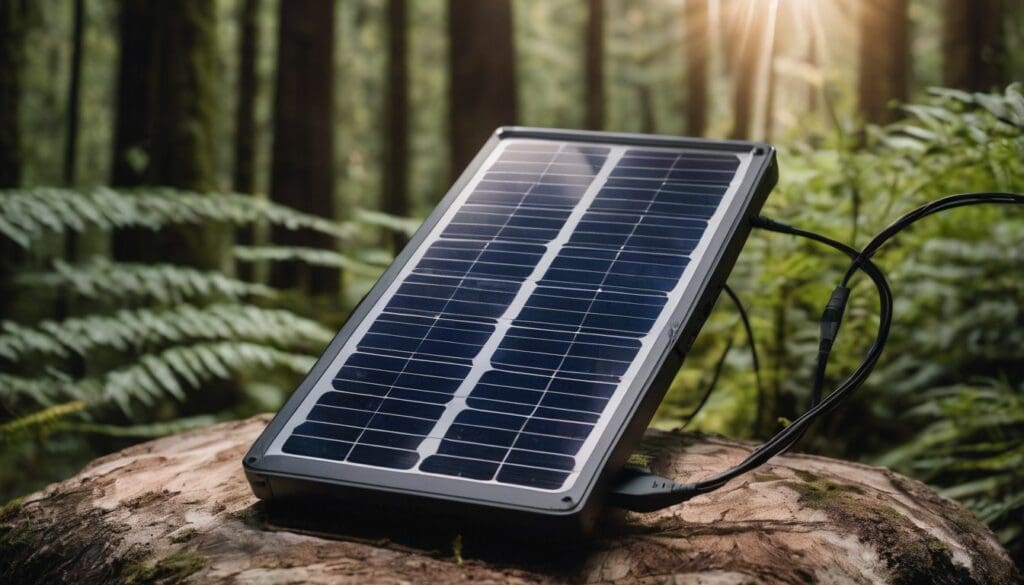We’re all well aware of the pressing need to look after our cherished planet, and yet, weaving together the threads of technology with sustainability can sometimes feel like a real head-scratcher.
It’s a conundrum that many of us share, but there’s reason for optimism – nearly 45% of consumers are now leaning towards eco-friendly tech options with enthusiasm. We’ve embarked on an enlightening journey into the realm of green gadgets so you don’t have to.
Let us steer you through a selection of clever choices for your technology essentials that promise not only to be savvy but also gentle on our precious Earth and its future prospects.
Embrace these innovations; they’re small steps towards a greener tomorrow that we can proudly hand down to generations yet to come.
Key Takeaways
- Consumers are increasingly demanding sustainable technology, leading to a rise in the market for green gadgets made with renewable materials or recycled plastics.
- Solar power is becoming more prevalent in eco – friendly devices as consumers and manufacturers alike recognise the importance of harnessing renewable energy sources.
- Government policies play an important role by offering incentives for purchasing energy – efficient electronics and setting environmental standards that encourage innovation in green technology.
- The adoption of low – carbon construction techniques and carbon capture storage represents a significant advancement towards reducing greenhouse gas emissions and combating climate change.
- As we move forward, continued investment in renewable energy storage systems such as those utilising hydrogen can significantly contribute to achieving a sustainable future.
The Rise of Eco-Friendly Gadgets
The rise of eco-friendly gadgets is driven by increasing consumer demand and the influence of peer purchasing habits. There has also been a surge in online searches for sustainable technology, as well as technological innovations and the trend towards solar power.
Government policies and agreements have further contributed to the emergence of eco-friendly gadgets.
Increasing consumer demand
We’re seeing a significant shift in buying patterns as more of us opt for green gadgets. Our collective desire for sustainable technology is visibly shaping the market, driving manufacturers to pay attention and meet our expectations.
Conscious consumer choices are no longer niche but a growing trend that’s influencing eco-friendly product development across the globe.
Our demand is speaking volumes, and it’s clear we want environmentally conscious devices that align with our values of conservation and environmental stewardship. Retailers are stocking up on energy-efficient gadgets constructed from renewable materials or recycled plastics, reflecting this surge in consumer interest.
We’re actively choosing sustainable electronics over conventional options, leading to an expansion in the availability of low-impact electronics designed for minimal environmental footprint.
Influence of peer purchasing habits
When choosing eco-friendly gadgets, consider the influence of peer purchasing habits. Many environmentally conscious individuals are influenced by the buying decisions of their peers and friends.
This social influence encourages them to make sustainable choices when it comes to technology and electronics, promoting a ripple effect in the shift towards green innovation.
Retailers catering to eco-conscious consumers offer a variety of energy-efficient gadgets, which further influences peer purchasing habits within this community. As more people opt for sustainable electronics, they inspire others to follow suit, creating a positive impact on the environment and driving demand for more eco-friendly innovations in the market.
Surge in online searches
With an increasing focus on sustainability in consumer habits, there has been a notable surge in online searches for eco-friendly gadgets and devices. Consumers are actively seeking out energy-efficient electronics, green innovations, and environmentally friendly gadgets to align with their conscious consumerism.
This shift is driving the demand for eco-conscious products and pushing the market towards sustainable gadgets and devices. As a result, ecotech retailers are witnessing a rise in searches for smart electrical panels, renewable energy devices, and low-impact electronics.
The trend reflects a growing awareness of the importance of green technology in supporting conservation efforts and promoting environmental protection.
Technological innovations
Technological innovations in green gadgets are revolutionising the electronics market. Energy-efficient technology, such as solar power trends and renewable energy storage, is becoming increasingly accessible to environmentally conscious individuals.
This shift towards eco-friendly devices is driven by a surge in online searches for low-impact electronics and government policies promoting sustainable innovations.
Emerging eco-conscious gadgets not only benefit the environment but also offer economic growth opportunities. The development of energy-efficient electronics and low-carbon construction techniques plays a crucial role in supporting conservation efforts.
Solar power trend
The solar power trend is gaining momentum in the green electronics market. Consumers are increasingly drawn to energy-efficient gadgets, driving innovations towards eco-friendly devices that harness solar power.
This shift aligns with our commitment to supporting conservation and environmental sustainability. The emergence of low-impact electronics reinforces our dedication to reducing carbon footprints and promoting eco-conscious gadgets.
As we explore the benefits of solar technology, we embrace a future where renewable energy storage becomes commonplace, leading the way for a more sustainable world.
Government policies and agreements
Government policies and agreements play a crucial role in driving the shift towards eco-friendly gadgets. Incentives, such as tax credits for purchasing energy-efficient devices, can encourage consumers to make sustainable choices.
Likewise, international agreements on reducing electronic waste and promoting recycling initiatives further reinforce the importance of embracing green technology. These policies create a supportive environment for manufacturers to invest in research and development of low-impact electronics, ultimately benefiting our environment.
Moreover, governmental regulations that enforce energy efficiency standards push companies to innovate and produce more eco-conscious gadgets. By collaborating with industry leaders and setting clear guidelines for sustainable practices, governments can significantly impact the adoption of green technology worldwide while addressing environmental concerns.
Emergence of eco-friendly gadgets
Consumers are driving the emergence of eco-friendly gadgets through their increasing demand for sustainable products. Technological innovations, such as solar-powered devices and energy-efficient electronics, are gaining popularity due to consumer influence and peer purchasing habits.
Online searches for eco-friendly devices have surged, indicating a growing interest in low-impact electronics. Furthermore, government policies and agreements support the development and adoption of eco-conscious gadgets, contributing to the rise of green technology.
Additionally, an emphasis on environmental protection has led to a surge in energy-efficient technology that aligns with sustainability goals. The emergence of these eco-friendly gadgets reflects a collective effort toward promoting conservation and environmental well-being.
Benefits of Green Technology
Green technology offers numerous benefits such as environmental protection, energy efficiency, economic growth, health and safety, and sustainability. Read on to discover how these advancements are shaping the future of sustainable living.
Environmental protection
When considering environmental protection, it’s vital to embrace eco-friendly gadgets that help reduce energy consumption and minimise electronic waste. Opting for energy-efficient electronics and low-impact devices not only conserves resources but also lowers greenhouse gas emissions, contributing to a healthier planet.
Embracing such innovations supports sustainability and fosters a greener future for generations to come.
Investing in eco-conscious gadgets promotes environmental protection through the reduction of carbon footprints and minimised use of non-renewable resources in electronic production, ultimately leading towards a more sustainable lifestyle.
Energy efficiency
Energy efficiency is a key aspect of green technology that focuses on reducing energy consumption and waste. Ecoconscious gadgets, such as low-impact electronics and energy-efficient devices, are designed to minimise their environmental footprint while delivering optimal performance.
By embracing eco-friendly innovations and investing in energy-efficient technology, individuals can contribute to the conservation of resources and the reduction of greenhouse gas emissions.
Implementing energy-efficient electronics not only supports environmental protection but also helps achieve economic growth. Energy efficiency promotes sustainability by cutting down on energy costs for households and businesses.
Economic growth
Transitioning from energy efficiency to economic growth, it is important to recognise that the adoption of green technology can stimulate economic growth by creating new job opportunities and fostering innovation.
By investing in eco-friendly gadgets and energy-efficient electronics, we contribute to the development of sustainable industries, supporting local economies and promoting overall financial stability.
Embracing green technology not only contributes to environmental conservation but also plays a significant role in enhancing economic prosperity while ensuring that future generations can thrive in a healthier environment.
Health and safety
Green technology not only benefits the environment but also contributes to our health and safety. Energy-efficient gadgets reduce harmful emissions, leading to cleaner air and a healthier living environment.
Low-impact electronics decrease the risk of exposure to hazardous materials, promoting better safety for both consumers and workers in the manufacturing process.
Incorporating eco-friendly innovations into our daily lives means prioritising our well-being while safeguarding the planet. As we prioritise health and safety, it’s essential to address potential challenges associated with implementing green technology effectively.
Sustainability
Sustainability entails making choices that consider the long-term impact on the environment and society. It involves using resources in a manner that meets current needs without jeopardising future generations’ ability to meet their own requirements.
The adoption of eco-friendly gadgets ensures reduced energy consumption along with environmental benefits. Embracing this approach helps conserve natural resources, reduce pollution levels, and limit greenhouse gas emissions.
Incorporating sustainable practices in technology usage is vital for safeguarding our planet’s health and addressing climate change concerns. By choosing energy-efficient gadgets and embracing low-impact electronics, individuals can contribute to fostering a greener future for all.
Challenges and Solutions in Implementing Green Technology
Implementing green technology comes with its own set of challenges, such as high costs and technological gaps, but with enhanced awareness and investment in green technology, we can overcome these barriers for a more sustainable future.
Interested to know more? Keep reading!
Addressing high costs
- Implementing energy-efficient gadgets can lead to long-term cost savings through reduced energy consumption.
- Investing in eco – friendly devices may initially incur higher costs but can result in lower maintenance and operating expenses over time.
- Exploring government incentives and subsidies for purchasing low-impact electronics can help offset initial expenditures.
- Collaborating with like – minded individuals and organisations can create opportunities for bulk purchases, driving down costs through economies of scale.
- Researching and comparing different green technology options to find the most cost – effective solutions for your specific needs.
- Seeking out financing options or grants available for implementing sustainable technology in homes or businesses.
Enhancing awareness
To increase adoption of green technology, it is important to enhance awareness. This can be achieved through:
- Educational campaigns: Organising workshops, seminars, and community events to educate the public about the benefits of eco-friendly gadgets.
- Collaboration with influencers: Partnering with environmental advocates and social media influencers to promote the use of energy-efficient electronics.
- Incorporating green technology in education: Introducing sustainable technology curriculum in schools and universities to instil environmental consciousness from a young age.
- Government incentives: Implementing policies that offer tax incentives or rebates for purchasing low-impact electronics, encouraging widespread adoption.
- Public engagement platforms: Creating online platforms and forums where individuals can share experiences and ideas about incorporating eco-friendly innovations into their daily lives.
Overcoming technological gaps
To overcome technological gaps, we can:
- Invest in research and development to bridge the technology divide.
- Collaborate with educational institutions to foster innovation and knowledge sharing.
- Implement mentorship programs to support the growth of green tech startups.
- Establish cross – sector partnerships for knowledge exchange and resource pooling.
- Provide incentives for businesses to adopt and adapt green technologies.
- Encourage open – source collaboration to accelerate the development of sustainable solutions.
- Foster a culture of continuous learning and adaptation within the industry.
Navigating regulatory barriers
Navigating regulatory barriers can be a complex task, but it is crucial to the success of implementing green technology. It involves understanding and complying with environmental regulations, obtaining necessary permits, and staying updated on policy changes. To manoeuvre through these challenges effectively, consider the following strategies:
- Collaborate with regulatory agencies and industry stakeholders to streamline compliance processes and ensure alignment with eco-friendly objectives.
- Conduct thorough research to understand the specific regulations relevant to green technology implementation, covering areas such as waste management, emissions standards, and resource conservation.
- Invest in staff training to enhance understanding of environmental laws and equip personnel with the knowledge needed for effective compliance.
- Engage legal experts specialising in environmental law to navigate complex regulatory landscapes and ensure adherence to stringent requirements.
- Proactively participate in public consultations and contribute insights to shape environmentally conscious policies for the benefit of the wider community.
Managing resistance
- Educate and inform: Providing comprehensive education on the benefits of green technology can help dispel misconceptions and build support.
- Collaboration and involvement: Involving stakeholders in the decision-making process fosters a sense of ownership and commitment to sustainable changes.
- Incentives and rewards: Offering incentives for adopting eco-friendly practices can motivate individuals and organisations to embrace green technology.
- Communication strategy: Developing a clear and compelling communication plan can effectively convey the importance of transitioning to sustainable solutions.
- Flexibility and adaptability: Remaining open to feedback and adjusting strategies based on real-world challenges can help overcome resistance.
Future of Green Technology
In the future, we can expect to see low-carbon construction, renewable energy storage, and investment in green technology. Read on to learn more about how technology is meeting sustainability goals.
Low-carbon construction
Green technology has paved the way for low-carbon construction, revolutionising the building industry to align with sustainability goals. By utilising renewable energy sources and integrating energy-efficient materials, low-carbon construction minimises environmental impact while maximising energy efficiency.
This approach includes employing eco-friendly building materials such as recycled steel and sustainably sourced timber, as well as incorporating innovative design techniques that reduce overall carbon emissions throughout a building’s lifecycle.
Moreover, low-carbon construction champions sustainable practices like passive solar heating, rainwater harvesting systems, and green roofs which enhance thermal performance and minimise climate footprint.
Carbon capture and storage
Carbon capture and storage technology captures carbon dioxide emissions at their source, preventing them from entering the atmosphere. It involves transporting the CO2 to a storage site where it is securely stored, usually deep underground.
This process helps to reduce greenhouse gas emissions and combat climate change, making it an essential tool in our efforts to transition towards a more sustainable future.
Furthermore, carbon capture and storage also enables industries such as power plants and manufacturing facilities to continue operating while reducing their environmental impact. By implementing this technology, we can significantly decrease our carbon footprint and work towards achieving a greener and healthier planet for generations to come.
Renewable energy storage
Transitioning from the concept of carbon capture and storage, we shift our focus to renewable energy storage. The advancement of green technology has led to groundbreaking developments in storing energy from sustainable sources such as solar, wind, and hydro power.
Energy systems are now equipped with efficient battery technologies capable of harnessing and preserving renewable energy for use during periods of low natural resource availability.
Renewable storage solutions enhance grid stability, reduce reliance on non-renewable resources, and contribute to a more sustainable future. With these advancements, environmentally conscious individuals can take an active role in supporting conservation efforts and minimising their environmental impact through the use of eco-friendly gadgets powered by renewable energy storage.
Hydrogen
Hydrogen offers an exciting opportunity to revolutionise green technology. It can be used as a clean energy source in fuel cells, generating electricity with only water and heat as byproducts.
Additionally, hydrogen has the potential to store excess renewable energy, providing a solution for intermittent power sources like solar and wind. Innovations in hydrogen production methods are making it increasingly viable for widespread adoption, offering promise for a sustainable and low-impact energy future.
Looking ahead at the future of green technology, we see even more potential growth in areas such as upcycling and investment in green technology.
Upcycling
Moving from the future prospects of hydrogen as a green technology, we shift our focus to upcycling – a practice that is gaining momentum in the sustainability movement. Upcycling involves creatively repurposing waste materials into new products or components with higher value and quality.
This process not only reduces the amount of waste destined for landfills but also minimises the need for raw materials, lowering energy consumption and environmental impact. Incorporating upcycled materials into electronic gadgets can significantly contribute to reducing their carbon footprint and promoting a more circular economy.
Upcycling offers an innovative approach to creating eco-friendly devices by utilising waste resources effectively. By embracing this concept, individuals can play an active role in mitigating environmental degradation while supporting sustainable manufacturing practices in the tech industry.
Investment in green technology
Investing in green technology is crucial for advancing sustainability and reducing environmental impact. Companies are increasingly allocating funds towards developing energy-efficient gadgets, low-impact electronics, and eco-friendly innovations.
This investment facilitates the creation of new technologies that contribute to environmental protection, energy efficiency, economic growth, and overall sustainability.
The development of renewable energy storage solutions and low-carbon construction techniques are key areas that require substantial investment. By investing in green technology such as carbon capture and storage facilities or hydrogen technologies, we can pave the way for a more sustainable future.
Conclusion
In summary, the future of green technology holds promise for a sustainable world. Innovative eco-friendly gadgets and energy-efficient devices are influencing positive change. We must continue to embrace these advancements to protect our environment while enjoying the benefits of technology.
Let’s work together to support conservation and environmental sustainability through the use of green gadgets.
FAQs
1. What are green gadgets?
Green gadgets are eco-friendly devices designed to use less energy and have a lower impact on the environment.
2. Why should I consider using energy-efficient electronics?
Using energy-efficient electronics helps you save money on electricity bills and supports sustainability efforts by reducing your carbon footprint.
3. Can eco-friendly products be as good as regular tech devices?
Yes, eco-friendly innovations in technology ensure that these products often perform just as well as their traditional counterparts while being better for the planet.
4. Are there many options when it comes to eco-friendly gadgets?
There’s a wide array of low-impact electronics available, from energy-efficient gadgets for your home to portable eco-friendly devices for on-the-go use.





